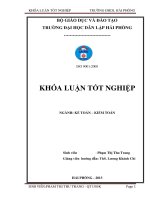factsheet tb tobacco sep09
Bạn đang xem bản rút gọn của tài liệu. Xem và tải ngay bản đầy đủ của tài liệu tại đây (212.7 KB, 2 trang )
TUBERCULOSIS
& TOBACCO
www.who.int/tb
www.who.int/tobacco
- A STRONG ASSOCIATION • Smoking substantially increases the risk of TB and death from TB
• More than 20% of global TB incidence may be attributable to smoking
• Controlling the tobacco epidemic will help control the TB epidemic
• Smoking is a risk factor for TB, independent of alcohol use and other socioeconomic
risk factors
• Smoking increases the risk of TB disease by more than two-and-a-half times
• The WHO monograph on TB and tobacco describes other linkages and evidence
40%
Correlation of High-Burden TB and High-Burden Tobacco Use Countries
The Tuberculosis Epidemic:
• 2 billion people are infected with the TB bacilli
• TB is a disease of poverty with the vast majority
of deaths occurring in low- and middle-income
countries with more than half of all deaths
occurring in Asia
• There were 9.27 million new TB cases in 2007
• 1.75 million people died from TB in 2007
• 5% of all TB cases have multidrug-resistant TB
Turkey
Germany
Japan
Brazil
USA
Bangladesh
Pakistan
0%
China
5%
India
10%
Indonesia
15%
South Africa
Proportion of global
tobacco smokers (2005)
20%
Russian
Federation
25%
• 5 countries feature in both the top 10 high-burden TB and top 10
high-burden tobacco use countries
• 40% of the TB burden in India may be attributed to smoking
• A dramatic reduction in smoking and exposure to indoor air
pollution in China could reduce TB incidence by up to half by 2033
Ethiopia
Proportion of global
TB cases (2007)
Myanmar
30%
Philippines
35%
The Tobacco Epidemic:
• More than 1 billion people smoke with
nearly 70% of them living in low- and middleincome countries
• Tobacco use is the leading preventable
cause of death
• More than 5 million people die per year from
tobacco use. Unchecked, the epidemic will kill
more than 8 million people per year by 2030
WHO-Recommended Policies to Combat Tobacco and TB
• Control tobacco everywhere, but especially where people are at risk of TB infection
• Coordinate national TB and tobacco control programmes
• Cross-train TB and tobacco control health workers
• Register TB patients' tobacco use and offer them counselling and treatment
• Promote and enforce smoke-free policies, particularly where TB services are delivered
• Integrate brief tobacco interventions (5 'A's and the 5 'R's) into TB control programme activities
• Implement smoking cessation procedures through PAL (the Practical Approach to Lung Health)
Public Health-Oriented Actions
TB control programmes can support
tobacco control by promoting policies to:
• Apply price and tax increases
• Provide protection from exposure to
tobacco smoke
• Ban tobacco advertising, promotion and
sponsorship
• Regulate the packaging and labelling of
tobacco products
• Raise public awareness of tobacco risks
• Treat tobacco dependence
These and other recommendations are
featured in the WHO Framework
Convention on Tobacco Control
Smoking cessation can be targeted
through PAL, the Practical Approach
to Lung Health, which:
• Is a patient-centred approach to
diagnosis and treatment of common
respiratory illnesses in primary health
settings
• Promotes symptom-based and
integrated management
• Seeks to standardize service delivery
through development and
implementation of clinical guidelines
PAL and other recommendations are
featured in the WHO Stop TB Strategy
Patient-Oriented Actions
The 5 'A's
ASK TB patients about their
tobacco use
ADVISE them to quit
ASSESS their willingness to
attempt to quit
ASSIST in their attempt to quit
ARRANGE follow up with them
The 5 'R's
RELEVANCE – ensure TB patients know their
treatment will be more effective if they quit smoking
RISKS – point out all the risks of continuing to smoke
including the risk of TB relapses
REWARDS – educate the TB patient about the many
other benefits of quitting smoking
ROADBLOCKS – ask the TB patient to identify
obstacles to quitting smoking
REPETITION – continue to encourage the TB patient
to quit smoking
Pilot Projects and Next Steps
• Egypt, Indonesia, and Nepal - smoking cessation actions have been introduced in health
services through PAL in pilot sites
• Kyrgyzstan - smoking cessation services are in place through PAL in the majority of the
primary health-care facilities of Kyrgyzstan
• Brazil - Smoking cessation has been included in TB-care services in Rio de Janeiro
Next Steps
• Monitor, evaluate and document smoking cessation through PAL and TB-care services
• Expand successful pilot projects to other target settings
• Increase political awareness of the worsening effects of the overlap of TB and tobacco use
• Raise awareness across ministerial departments on the health, social and economic benefits of
strengthening joint TB and tobacco control
© WHO Sep 2009









